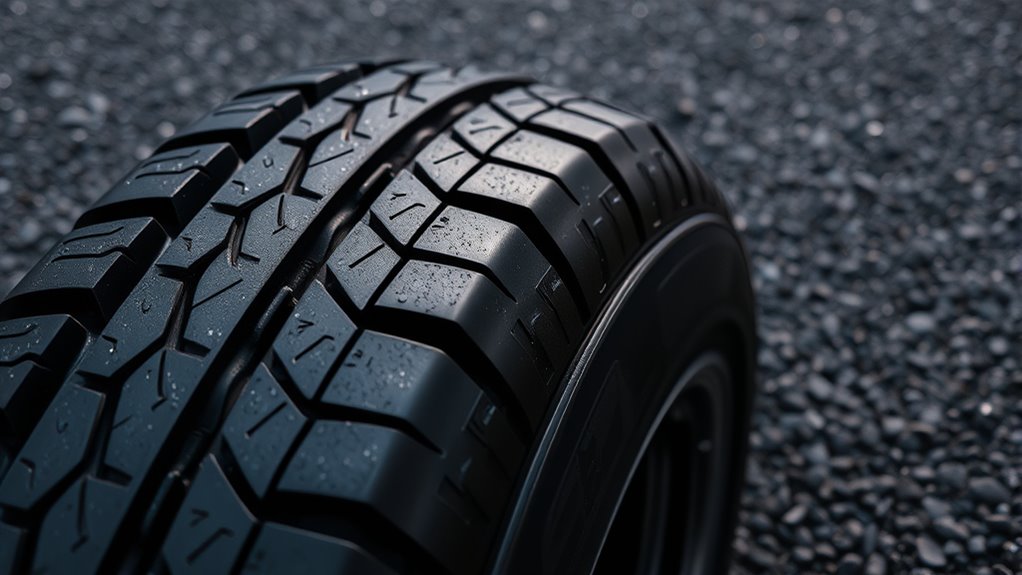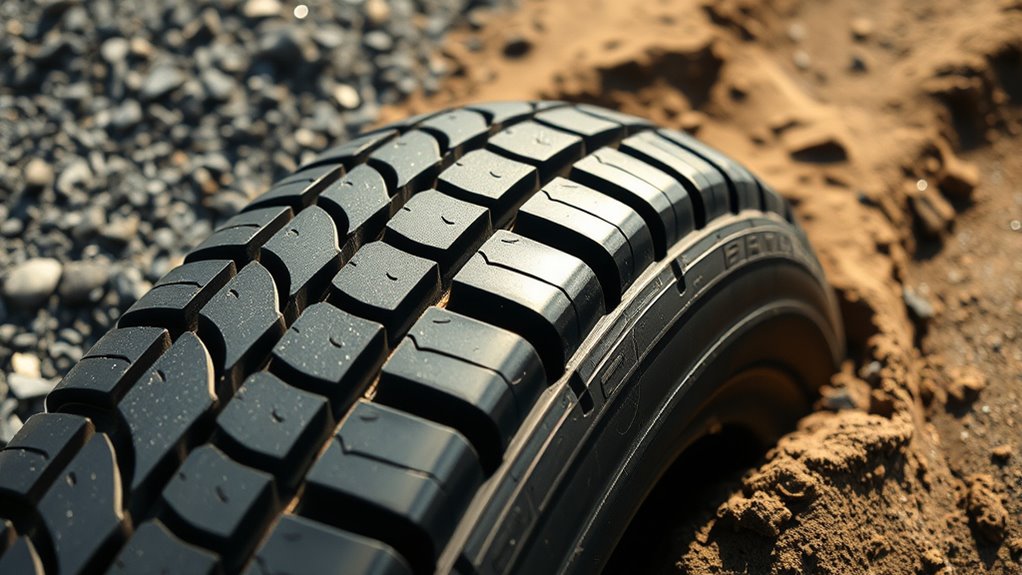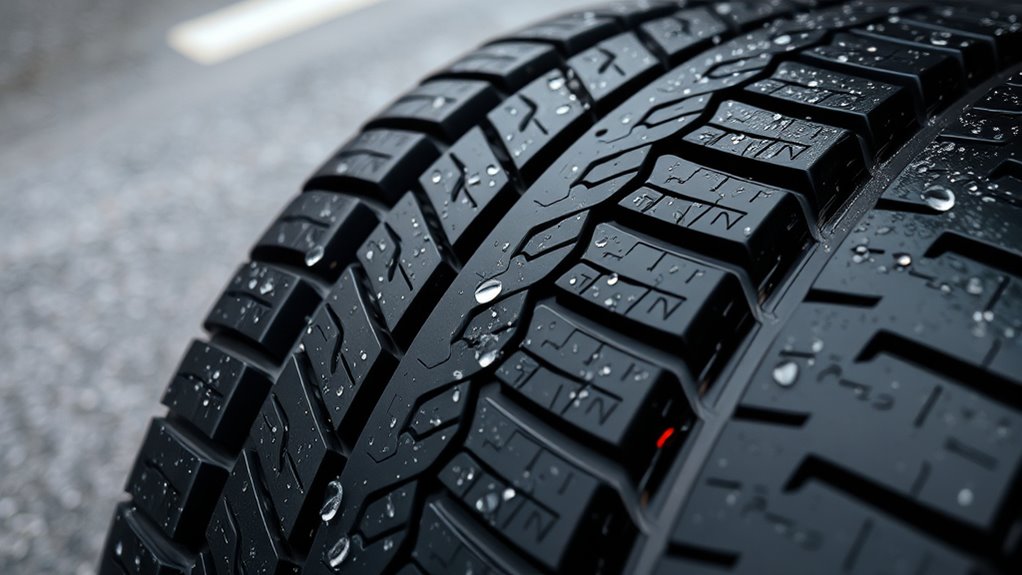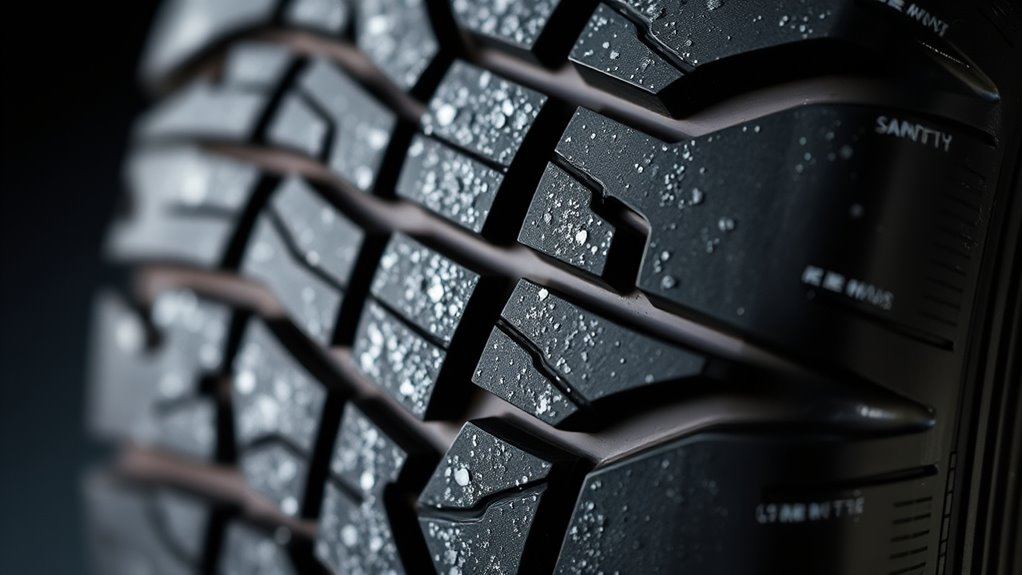Tire compounds combine natural and synthetic rubbers, fillers, and chemical additives to maximize performance on different surfaces. Additives like antioxidants prevent degradation, while fillers such as silica or carbon black boost durability and grip. By tuning these materials, manufacturers optimize flexibility, temperature resistance, and wear life for wet, dry, or off-road conditions. The hidden science guarantees your tires perform safely and efficiently wherever you go—discover more about how these complex blends work behind the scenes.
Key Takeaways
- Tire compounds are formulated with specific polymers, fillers, and additives to optimize performance for different surfaces.
- Silica fillers enhance wet traction and reduce rolling resistance, improving efficiency on smooth and wet surfaces.
- Chemical additives like antioxidants and anti-ozonants extend tire lifespan by preventing environmental degradation.
- Tread pattern design and compound flexibility are tailored to surface conditions such as off-road, highway, or icy terrain.
- Advances in eco-friendly materials and sensor technology enable tires to adapt and perform efficiently across diverse environments.
The Composition of Tire Rubber Blends

Understanding the composition of tire rubber blends is essential because it directly influences the tire’s performance, durability, and safety. You achieve this through polymer blending, where different polymers are combined to optimize flexibility, grip, and wear resistance. These blends often include natural rubber, synthetic rubbers, and fillers to enhance specific properties. Vulcanization techniques play a critical role here, as they chemically cross-link the rubber molecules, improving elasticity and strength. The precise balance of polymers and the vulcanization process determine how well the tire withstands various stresses, from heat to abrasion. polymer blending techniques are carefully engineered to achieve the desired balance of traits in the final product. By carefully controlling these factors, manufacturers create tire rubber blends that deliver a reliable, safe, and high-performing driving experience across different surfaces.
How Chemical Additives Enhance Performance

Chemical additives are essential in boosting tire performance by tailoring specific properties to meet demanding driving conditions. These chemical additives improve traction, flexibility, and resistance to wear, ensuring your tires perform effectively on different surfaces. By carefully selecting additives like antioxidants, accelerators, and anti-ozonants, manufacturers achieve performance enhancement tailored to specific needs. For example, antioxidants prevent rubber degradation from environmental exposure, maintaining tire integrity over time. Additionally, dog names can be used as a creative analogy for naming tire compounds based on their unique qualities. The use of chemical formulations allows for precise control of tire characteristics, optimizing performance for various conditions. Incorporating innovative materials further enhances durability and adaptability in diverse environments. Moreover, understanding the compound blending process is crucial for developing tires that balance performance, longevity, and safety. For instance, the inclusion of specialized antioxidants can prolong the lifespan of tires exposed to harsh climates. Overall, chemical additives play a vital role in refining tire characteristics, allowing you to experience safer, more reliable driving, regardless of surface or weather conditions. Their strategic use directly contributes to the tire’s overall performance and longevity.
The Role of Fillers in Tire Durability

Fillers play a vital role in determining your tire’s durability by enhancing strength and wear resistance. Different types, like carbon black and silica, have unique properties that directly affect how long your tire lasts. Understanding how these fillers impact lifespan helps you choose tires that perform better over time. For example, silica-based fillers can improve wet traction and reduce rolling resistance, contributing to longer tire life and better fuel efficiency antioxidants in honey. Additionally, incorporating proper filler types can significantly influence the tire’s resistance to aging and environmental factors, further extending its service life. Advances in material science continue to develop new filler compounds that enhance tire performance even further. Recognizing the importance of wall organization systems can also aid in maintaining the overall health and safety of your vehicle, indirectly supporting tire longevity.
Filler Types and Properties
Fillers play a crucial role in enhancing tire durability by reinforcing the rubber matrix and improving its overall performance. Different filler types offer unique properties that influence tire characteristics. For example, carbon black boosts strength and reduces tire noise, while silica enhances wet traction and lowers rolling resistance. You’ll notice that the choice of filler affects manufacturing processes, as some require specific handling to guarantee proper dispersion. Key aspects include:
- Tire noise reduction through optimized filler distribution
- Enhanced durability by increasing abrasion resistance
- Improved wet traction with silica-based fillers
- Manufacturing efficiency influenced by filler type and mixing techniques
Additionally, understanding the efficiency ratings of fillers helps manufacturers select optimal materials for specific tire applications, ensuring better performance and longevity. Regular testing of filler materials also ensures consistent quality, which is vital for maintaining tire safety standards. Recognizing the dispersion quality of fillers during manufacturing is essential to prevent inconsistencies that could compromise tire integrity. The ability to control filler dispersion directly impacts the overall manufacturing process and final product quality. Understanding these properties helps tailor tires for specific surfaces, ensuring safety and performance.
Impact on Tire Lifespan
The choice of filler directly impacts how long your tires last. Fillers influence tire durability by strengthening the rubber matrix, making it more resistant to wear and tear. High-quality fillers can reduce tire noise, creating a smoother, quieter ride that preserves tire integrity over time. Additionally, fillers play a key role in aesthetic design, helping maintain the tire’s appearance and preventing cracking or discoloration. Proper filler selection minimizes degradation from exposure to elements like UV rays and ozone, extending lifespan. By enhancing the tire’s resilience and maintaining its visual appeal, fillers ensure you get more mileage out of each set. Furthermore, understanding how fillers interact with different surface conditions can optimize tire performance in various environments. The use of advanced filler materials can also contribute to better overall tire performance and longevity. Ultimately, choosing the right fillers not only improves performance but also adds to the overall longevity of your tires.
Tuning Flexibility and Grip for Different Surfaces

Your tire’s rubber compound composition and tread pattern design play vital roles in adjusting flexibility and grip for various surfaces. By tuning these factors, you can optimize performance whether you’re on wet roads, rocky trails, or smooth tracks. Understanding how each element influences traction helps you choose the right setup for any terrain. Incorporating advanced manufacturing techniques can further enhance the performance and durability of tire compounds across different surfaces. Additionally, considering material properties ensures that the tire maintains optimal flexibility and grip tailored to specific environments.
Rubber Compound Composition
Ever wondered how tire manufacturers tailor rubber compounds to optimize flexibility and grip across different surfaces? It all comes down to rubber compound composition. By adjusting the types and proportions of polymers, fillers, and additives, you can influence tire performance. For example:
- Selecting softer compounds enhances grip on smooth surfaces but may increase tire noise.
- Incorporating specific fillers like silica reduces rolling resistance and tire noise.
- Adjusting curing times and temperatures during manufacturing processes impacts flexibility and durability.
- Using certain rubber blends helps balance grip and wear resistance across varied terrains.
- Understanding the subtopic of tire composition allows for better customization and performance tuning.
- The process of compound formulation involves precise control over material ratios to meet specific performance criteria.
- Knowing how different budgeting tips can be applied helps manufacturers optimize costs without sacrificing quality.
- The material selection process in rubber compounds is crucial for achieving desired surface performance and longevity.
These choices directly affect how your tires perform, ensuring better grip where needed while minimizing tire noise. Understanding this composition helps manufacturers create tires tailored for different conditions, optimizing safety and comfort on every surface.
Tread Pattern Design
Tread pattern design plays a crucial role in tuning a tire’s flexibility and grip for different surfaces. By optimizing the arrangement and shape of tread blocks, you enhance traction where you need it most. Tire tread innovation focuses on balancing water evacuation, grip, and durability. Different patterns suit specific environments, from smooth highways to off-road terrains. Paying attention to Vetted tire models can help you select the best pattern for your needs.
| Surface Type | Tread Pattern Focus | Key Benefit |
|---|---|---|
| Wet roads | Siping and channels | Water dispersion |
| Off-road | Deep lugs | Mud and rocks grip |
| Dry pavement | Continuous ribs | Stability and grip |
This focus on tread pattern design helps you achieve better control and safety. By choosing the right pattern, you adapt your tires to your driving needs, making every surface more manageable.
Tuning Flexibility and Grip
Adjusting tire flexibility and grip is essential for optimizing performance across different surfaces. You can fine-tune this by modifying tire pressure and sidewall stiffness. Lower tire pressure increases flexibility, enhancing grip on loose or uneven terrain, while higher pressure reduces deformation, ideal for smooth surfaces. Softer sidewalls provide more flex, improving traction on rough or rocky ground, whereas stiffer sidewalls offer stability on paved surfaces. To adapt quickly:
- Increase tire pressure for hard, smooth surfaces
- Decrease tire pressure for loose or rocky terrains
- Soften sidewalls for better grip on uneven ground
- Firm up sidewalls for stability on high-speed, paved roads
Balancing tire pressure and sidewall stiffness helps you optimize grip and flexibility, ensuring better control and safety tailored to each surface you encounter.
Temperature Resistance and Its Impact on Traction

Temperature resistance plays a crucial role in determining how well a tire maintains traction under different conditions. When a tire has good temperature stability, it can perform consistently whether you’re driving in the heat or cold. This stability directly impacts traction performance, ensuring your tires grip the surface effectively without slipping. If a compound loses its integrity at high temperatures, traction diminishes, especially during aggressive driving or hot weather. Conversely, materials that remain stable in cold conditions help prevent loss of grip on icy or snowy surfaces. Understanding how temperature resistance influences the tire’s ability to adapt to varying temperatures helps you choose the right compound for your driving environment, ensuring safety and peak performance no matter the climate.
Wear-Resistant Compounds for Longevity

Durability is a key factor when selecting tire compounds, especially if you want your tires to last longer. Wear-resistant compounds are engineered to withstand constant friction, reducing the rate of tread wear and extending tire lifespan. Achieving this involves balancing durability with other factors like tire noise and manufacturing costs.
- Using durable rubber blends minimizes tire noise caused by uneven wear and vibrations.
- Incorporating tougher fillers or cross-linked polymers enhances longevity without substantially raising manufacturing costs.
- Thicker tread compounds resist cuts and punctures, making them ideal for harsh surfaces.
- Optimizing manufacturing processes ensures consistent quality while managing costs.
Innovations in Eco-Friendly Tire Materials

Innovations in eco-friendly tire materials focus on reducing environmental impact without compromising performance. Manufacturers are embracing recycling initiatives and manufacturing innovations to create sustainable options. These efforts include using bio-based rubbers, reclaimed plastics, and natural fillers that lower carbon footprints. By adopting these methods, you help reduce waste and reliance on finite resources. The table below highlights key benefits of eco-friendly tires:
| Benefit | Impact |
|---|---|
| Reduced landfill waste | Less environmental pollution |
| Lower carbon emissions | Combats climate change |
| Sustainable resource use | Ensures future availability |
These advancements evoke hope and responsibility. As you choose eco-friendly tires, you’re supporting a cleaner, more sustainable future for everyone.
Testing and Refining Tire Compounds for Surface-Specific Performance

To optimize tire performance for specific surfaces, manufacturers rigorously test and refine tire compounds through controlled experiments and real-world evaluations. During surface testing, you evaluate how different compounds grip, wear, and react under various conditions. This process helps identify the best formulations for each surface type. Key steps in tire manufacturing include:
- Conducting laboratory tests to measure traction and abrasion resistance
- Using track and road trials to observe real-world performance
- Adjusting chemical compositions based on test results
- Ensuring consistency across production batches for surface-specific needs
Future Trends in Tire Compound Engineering

Advancements in tire compound engineering are shaping the future of vehicle safety, efficiency, and environmental sustainability. You can expect smarter materials that adapt to changing conditions, optimizing grip and wear. Future tire designs will better monitor tire pressure and wheel alignment in real-time, alerting you to issues before they affect performance or safety. Innovations will focus on lightweight, eco-friendly compounds that reduce rolling resistance and lower emissions. Additionally, tire sensors integrated into the compounds will provide data to improve maintenance, extending lifespan and ensuring ideal contact with the road. These trends aim to enhance your driving experience by making tires more responsive, durable, and sustainable, ultimately supporting safer, more efficient journeys across all surfaces.
Frequently Asked Questions
How Do Tire Compounds Adapt to Extreme Weather Conditions?
When facing extreme weather, your tire compounds adapt through changes in rubber elasticity and chemical stability. In cold conditions, they stay flexible, maintaining grip by preventing rubber from becoming brittle. During heat, compounds become more stable, resisting breakdown and reducing wear. These adaptations ensure your tires perform reliably across various temperatures, keeping you safe. Advances in tire chemistry enable these compounds to respond effectively, providing ideal traction and durability regardless of weather extremes.
Can Different Tire Compounds Be Combined for Mixed-Surface Driving?
You can indeed combine different tire compounds for mixed-surface driving through compound blending, which enhances surface adaptability. This process involves integrating compounds with distinct properties, allowing your tires to perform well on various terrains like asphalt, gravel, or snow. By choosing the right blend, you guarantee better traction, durability, and comfort across diverse conditions, making your driving experience safer and more efficient on mixed surfaces.
What Role Does Noise Reduction Play in Tire Compound Design?
You might wonder how noise reduction influences tire design. In this context, sound mitigation and vibration control are essential. Tire compounds are engineered to absorb vibrations and minimize noise, making your ride smoother and quieter. By incorporating specific materials and structures, manufacturers reduce sound transmission, especially on rough surfaces. This focus enhances comfort and safety, ensuring you experience less disturbance from road noise while driving, regardless of the surface you’re on.
How Do Tire Compounds Influence Fuel Efficiency?
Think of tire compounds as the engine’s secret sauce, directly affecting fuel efficiency. You benefit when rubber elasticity is optimized, allowing the tire to roll smoothly with less resistance. Chemical additives improve durability and reduce friction, which means less energy is lost. This combination helps your vehicle use fuel more efficiently, saving you money and reducing emissions, all while maintaining grip and safety on the road.
Are There Specific Compounds for Electric Vehicle Tires?
Electric vehicle tire compounds are specially designed to optimize performance. You’ll find that these compounds focus on reducing rolling resistance, which helps improve range. They often include materials that provide better grip and durability, tailored for EVs’ heavier batteries and instant torque. By choosing tires with specific compounds for electric vehicles, you get enhanced efficiency, safety, and longevity, making your EV driving experience smoother and more cost-effective.
Conclusion
Now that you know the secret science behind tire compounds, you can’t unsee it. Every twist, turn, and grip is powered by mind-blowing chemistry working tirelessly beneath your wheels. From eco-friendly innovations to surface-specific magic, tire technology is evolving faster than you can imagine—unlocking performance you never thought possible. So next time you hit the road, remember: beneath every tire is a hidden genius, transforming your drive into an extraordinary adventure!









